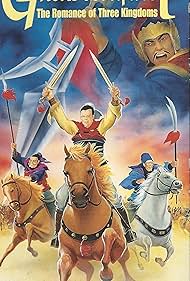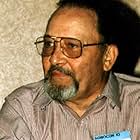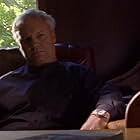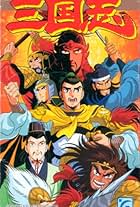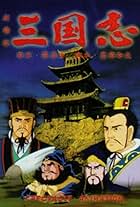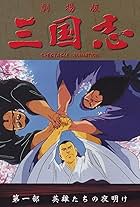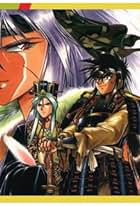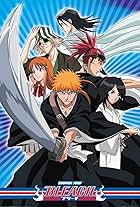Doug Stone
- Bei (1994)
- (English version)
- (voice)
Mike Reynolds
- Cho (1994)
- (English version)
- (voice)
Barbara Goodson
- Mom
- (English version)
- (voice)
- …
J.C. Henning
- Li-Hua (1994)
- (English version)
- (voice)
- (as Joan-Carol O'Connell)
Jeff Winkless
- Kung
- (English version)
- (voice)
- …
Joyce Kurtz
- Walla (1994)
- (English version)
- (voice)
Michael Forest
- Ts'ao (1994)
- (voice)
Kerrigan Mahan
- Coworker
- (voice)
- …
John Tremaine
- Officers
- (English version)
- (voice)
- …
Cam Clarke
- Chuko (1994)
- (English version)
- (voice)
David Povall
- Liao
- (English version)
- (voice)
- …
Kirk Thornton
- Enforcer
- (English version)
- (voice)
- …
Michael McConnohie
- Fei
- (English version)
- (voice)
- …
Bob Bergen
- Chuko (1994)
- (English version)
- (voice)
Brianne Brozey
- Ts'ao
- (English version)
- (voice)
- …
Gregory Snegoff
- Yu
- (English version)
- (voice)
- …
Steve Kramer
- Chia
- (English version)
- (voice)
- …
Edie Mirman
- Chen
- (English version)
- (voice)
- …
- Directors
- Writer
- All cast & crew
- Production, box office & more at IMDbPro
Storyline
Featured review
SANGOKUSHI (1992), released in an English-dubbed version as GREAT CONQUEST: THE ROMANCE OF THREE KINGDOMS, is a Japanese animated adaptation of parts of one of the great works of Chinese literature, an account of the wars and political struggles that led to the unification of China nearly 2000 years ago. The film is filled with sweeping battle scenes and violent political upheavals and recreates ancient China as magnificently as possible in anime. At its heart is a story of enduring friendship and undying love.
The screenplay here focuses on the character of Liu Bei, a farm boy of royal blood, who is thrust into the tide of history when he joins with his two sworn brothers, the robust and impulsive Chang Fei and the shrewd scholar-warrior Kwang Yu, to form a unit of volunteers to help suppress a movement of rebel fanatics known as the Yellow Turbans. The rise and fall in the fortunes of Liu Bei and his allies are paralleled by the shifts in power among the ruling elite in the central valley and Yellow River Basin of China. At any given point in the film, Liu Bei and his loyal followers are being asked to either help a former enemy or attack a former ally, so fragile are the alliances that make up the political and military landscape of the era.
The two-hour film compresses a lot of detail and a large cast of characters into the narrative, but manages to perform a deft balancing act by keeping the focus on Liu Bei and his friends and bringing the action back to them when things start to get complicated elsewhere. As a result, the audience has an emotional hook to keep them engaged throughout. Liu Bei is an honorable young man and a believable character. He's not a superhuman fighter and doesn't always make the right decisions. He's troubled by his failure to rescue his beloved Li-Hua from slavers at a key point in the story and by his inability, much later on, to protect her from being taken hostage by a rival general. But it's Liu Bei's friendship with Chang Fei and Kwang Yu, the two men he adopts as "sworn brothers" early in the film (a practice familiar to readers of historical Chinese novels and fans of old-school kung fu movies), that forms the emotional core of the sprawling storyline.
A spectacle of this magnitude requires a lot of large-scale battles so we get to see armies of thousands go into action on the plains and mountain valleys and laying siege to fortified cities. In addition there are plenty of one-on-one confrontations, usually on horseback with lance and sword most commonly employed. While the battle scenes are not as long as we'd like them, the animation quality is of a high order and plunges us right into the middle of the action as men rush at each other, rear their horses around and swing swords, lances, whips and other implements into the fray.
Overall, it's a spectacular production, with stunning background artwork depicting the valleys, woods and mountains of China as well as the palatial seats of power and the more humble villages where most of the characters hail from. The costumes are also quite impressive and done with great detail and care. The character design is probably a little simpler than it ought to be and the character movement somewhat stiffer in the non-action scenes, but these are small complaints when weighed against the consistent strength of the visual design throughout.
The screenplay is by Kazuo Kasahara and the on screen director credit is given to Tomoharu Katsumata (also known for ARCADIA OF MY YOUTH, the Captain Harlock feature from 1982), although the video box credits Masahara Okuwaki. In either case, the filmmakers have created an almost perfect model of how an animated historical epic should look. The makers of Disney's MULAN (1998) could have learned much from this film about how a serious (closely related) historical subject should be properly treated on screen.
Earlier animated versions of SANGOKUSHI were done as specials for Japanese television in 1982, 1985 and 1986, while a 42-episode TV series was produced in 1991. The 1992 theatrical movie version reviewed here is the only edition that has been released in English and only on tape. The English dub includes very helpful narration voiced by Japanese-American actor Pat Morita.
ADDENDUM (10/22/23): Since submitting this review 21 years ago, based on seeing an English-dubbed version on VHS tape, I've acquired and watched a DVD edition from Discotek Media containing a longer print of the film in Japanese with English subtitles. It's 22 minutes longer than the English dub and includes much more graphic violence in all the battle scenes, including beheadings and dismemberment, as well as separate scenes of torture. I complained in my original review that the battles were "not as long as we'd like them," but little did I know that these scenes had been severely shortened in the English dub.
The screenplay here focuses on the character of Liu Bei, a farm boy of royal blood, who is thrust into the tide of history when he joins with his two sworn brothers, the robust and impulsive Chang Fei and the shrewd scholar-warrior Kwang Yu, to form a unit of volunteers to help suppress a movement of rebel fanatics known as the Yellow Turbans. The rise and fall in the fortunes of Liu Bei and his allies are paralleled by the shifts in power among the ruling elite in the central valley and Yellow River Basin of China. At any given point in the film, Liu Bei and his loyal followers are being asked to either help a former enemy or attack a former ally, so fragile are the alliances that make up the political and military landscape of the era.
The two-hour film compresses a lot of detail and a large cast of characters into the narrative, but manages to perform a deft balancing act by keeping the focus on Liu Bei and his friends and bringing the action back to them when things start to get complicated elsewhere. As a result, the audience has an emotional hook to keep them engaged throughout. Liu Bei is an honorable young man and a believable character. He's not a superhuman fighter and doesn't always make the right decisions. He's troubled by his failure to rescue his beloved Li-Hua from slavers at a key point in the story and by his inability, much later on, to protect her from being taken hostage by a rival general. But it's Liu Bei's friendship with Chang Fei and Kwang Yu, the two men he adopts as "sworn brothers" early in the film (a practice familiar to readers of historical Chinese novels and fans of old-school kung fu movies), that forms the emotional core of the sprawling storyline.
A spectacle of this magnitude requires a lot of large-scale battles so we get to see armies of thousands go into action on the plains and mountain valleys and laying siege to fortified cities. In addition there are plenty of one-on-one confrontations, usually on horseback with lance and sword most commonly employed. While the battle scenes are not as long as we'd like them, the animation quality is of a high order and plunges us right into the middle of the action as men rush at each other, rear their horses around and swing swords, lances, whips and other implements into the fray.
Overall, it's a spectacular production, with stunning background artwork depicting the valleys, woods and mountains of China as well as the palatial seats of power and the more humble villages where most of the characters hail from. The costumes are also quite impressive and done with great detail and care. The character design is probably a little simpler than it ought to be and the character movement somewhat stiffer in the non-action scenes, but these are small complaints when weighed against the consistent strength of the visual design throughout.
The screenplay is by Kazuo Kasahara and the on screen director credit is given to Tomoharu Katsumata (also known for ARCADIA OF MY YOUTH, the Captain Harlock feature from 1982), although the video box credits Masahara Okuwaki. In either case, the filmmakers have created an almost perfect model of how an animated historical epic should look. The makers of Disney's MULAN (1998) could have learned much from this film about how a serious (closely related) historical subject should be properly treated on screen.
Earlier animated versions of SANGOKUSHI were done as specials for Japanese television in 1982, 1985 and 1986, while a 42-episode TV series was produced in 1991. The 1992 theatrical movie version reviewed here is the only edition that has been released in English and only on tape. The English dub includes very helpful narration voiced by Japanese-American actor Pat Morita.
ADDENDUM (10/22/23): Since submitting this review 21 years ago, based on seeing an English-dubbed version on VHS tape, I've acquired and watched a DVD edition from Discotek Media containing a longer print of the film in Japanese with English subtitles. It's 22 minutes longer than the English dub and includes much more graphic violence in all the battle scenes, including beheadings and dismemberment, as well as separate scenes of torture. I complained in my original review that the battles were "not as long as we'd like them," but little did I know that these scenes had been severely shortened in the English dub.
- BrianDanaCamp
- Aug 23, 2002
- Permalink
Details
- Release date
- Country of origin
- Language
- Also known as
- Great Conquest: The Romance of 3 Kingdoms
- Production companies
- See more company credits at IMDbPro
Contribute to this page
Suggest an edit or add missing content

